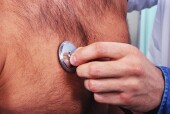
FRIDAY, April 22 (HealthDay News) — U.S. health officials and the American Heart Association have put forth an ambitious set of goals for reducing deaths from heart attack, stroke and coronary heart disease.
The goals go further than just setting targets for limiting death and illness, however. They place even greater emphasis on prevention, calling for behavioral change that could benefit overall public health, if successful.
“The goal is to shift the population to a healthier lifestyle,” said Dr. Ralph L. Sacco, president of the American Heart Association and chairman of neurology at the University of Miami Miller School of Medicine. “It’s a much more prevention-oriented goal than we have had in the past.”
The goals are part of the Healthy People 2020 goals, issued by the U.S. Department of Health and Human Services and aimed at improving the nation’s health in the next decade. But with heart attack and stroke ranking first and third, respectively, on the list of leading causes of death in the United States, heart-oriented objectives form a substantial part of the initiative.
The program’s heart-health goals start with typical targets, calling for a 20 percent reduction in deaths from coronary heart disease and stroke. But then Healthy People 2020 goes further, setting goals for specific prevention activities, including:
- Increasing the number of people who have had their blood pressure and cholesterol tested recently.
- Increasing the number of people who have taken preventive measures to reduce high blood pressure or high cholesterol.
- Raising awareness of the early warning signs and symptoms of heart attack and stroke.
The American Heart Association takes this approach even further with what the organization calls its 2020 Impact Goal: to improve the cardiovascular health of all Americans by 20 percent while reducing deaths from cardiovascular diseases and stroke by 20 percent.
The association has identified a set of health measures it refers to as “Life’s Simple 7,” which, if followed, will lead to good cardiovascular health. The measures are:
- Get active. For most people this means at least 150 minutes of moderate intensity exercise or 75 minutes of vigorous intensity exercise each week.
- Control cholesterol. Aim for a total cholesterol level of less than 200 milligrams per deciliter (mg/dL).
- Eat better. Increase consumption of vegetables and fruits, whole grains and fish and cut back on fats and sodium.
- Manage blood pressure. Keep the reading below 120/80.
- Lose weight. Keep your body mass index (BMI) below 25. BMI is an indicator of body fatness calculated from a person’s weight and height.
- Reduce blood sugar. Fasting blood glucose should be less than 100 mg/dL.
- Don’t smoke.
“The focus expands pretty broadly the concept of prevention, in that not only should we focus on prevention after someone has developed high-risk factors, we should also try to prevent someone developing those risk factors in the first place,” said Dr. Donald Lloyd-Jones, chairman of preventive medicine at Northwestern University’s Feinberg School of Medicine.
Lloyd-Jones calls such an approach “primordial prevention” because it focuses on improving and maintaining the health of people who are already healthy.
“Once you’ve developed risk factors, treatment can never restore you to the baseline risk factor of someone who has never had them,” he said. “Your chances of living a healthier, longer life with better quality of life are substantially better.”
The cornerstone of “Life’s Simple 7” are the goals related to diet, exercise and smoking, Sacco and Lloyd-Jones said, because improving those three factors will prompt better overall health.
“When you start with behavior like diet and physical activity, it improves everything else,” Sacco said. “They’re all kind of interlinked.”
To pursue these goals, health officials will have to change their own behavior as well, Sacco and Lloyd-Jones said.
Sacco predicts that health behavior scientists who study how people view and pursue a healthy lifestyle will have a greater role to play over the next decade. Motivational counselors and fitness counselors also will be needed to help keep people focused and inspired.
“People who are in advertising work very effectively to advertise products and change behavior,” he said. “We have to do just as well to market healthy behaviors. We also have to constantly assess what programs or procedures or activities are effective in changing the behavior. It’s one thing to understand the cause and it’s another thing to intervene, and we really want to focus on intervention.”
The goals also will require some changes in public policy. Examples include designing communities to promote walking, increasing access to fresh fruits and vegetables nationally, and working with manufacturers to reduce levels of sodium in food, Lloyd-Jones said.
Public policy can be key in promoting overall public health, he said, noting the increasing number of indoor smoking bans across the country.
“The data are unequivocal,” Lloyd-Jones said. “Hospitalization rates for heart attacks drop dramatically within months of the institution of an indoor smoking ban.”
Sacco and Lloyd-Jones admit that the goals set by the government and the American Heart Association are ambitious, but well worth striving toward.
“I think they are what I would call ‘stretch’ goals,” Lloyd-Jones said. “But the truth is, if we are even mostly successful in the next decade, then the benefits we will see will be enormous. We must start now.”
More information
The American Heart Association has more on becoming heart-healthy.
For more on what it takes to get heart healthy, read about one woman’s efforts.

